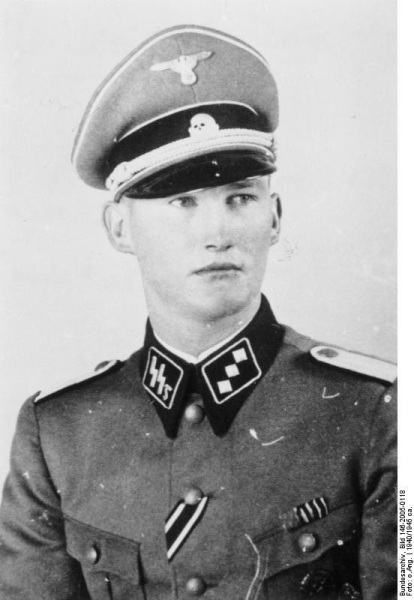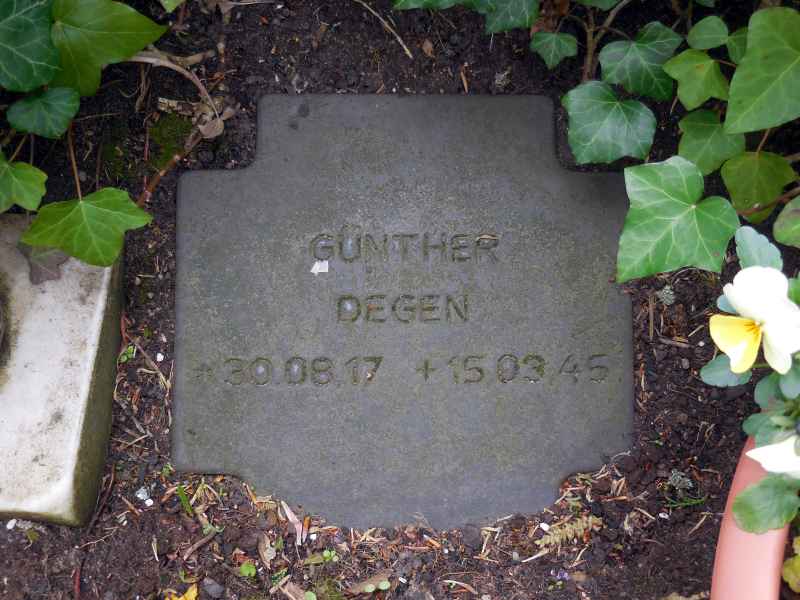Degen, Günther (Waffen SS)
- Date of birth:
- August 30th, 1917 (Bispingen-Soltau/Hanover, Germany)
- Date of death:
- March 13th, 1945 (near Pfaffenheck/Hunsrück, Germany)
- Buried on:
- German War Cemetery Pfaffenheck
Grave: UNK. - Service number:
- SS-Nr.: 314.127 // NSDAP-Nr.:
- Nationality:
- German
Biography
19.07.1935: SS-Verfügungstruppe
01.09.1939-28.02.1940: Lehrgang, SS-Junkerschule Bad Tölz
25.09.1939: promoted to SS-Unterscharführer
01.01.1940: promoted to SS-Standartenjunker
15.02.1940: promoted to SS-Untersturmführer
00.03.1940: Stamm-Personal, SS-Junkerschule Bad Tölz
01.09.1940: SS-Ustuf, Zugführer, III. Sturmbann, SS-Standarte "Germania", SS-Division 'Wiking'
00.11.1941-10.04.1942: Lehrgang, SS-Unterführerschule Lauenburg
12.04.1942: SS-Ustuf, III. Bataillon, SS-Gebirgsjäger-Regiment 11, SS-Division 'Nord'
00.04.1942: promoted to SS-Obersturmführer
30.01.1944: promoted to SS-Hauptsturmführer
08.07.1944: SS-Hauptsturmführer, Führer, I. Bataillon, SS-Gebirgsjäger-Regiment 11 'Reinhard Heydrich', 6. SS-Gebirgs-Division 'Nord'
18.09.1944: heavy fightings in Tuhkala, Finnland
13.03.1945: WIA, DOW near Pfaffenheck, Hunsrück
Do you have more information about this person? Inform us!
- Period:
- Second World War (1939-1945)
- Awarded on:
- September 15th, 1939
- Period:
- Second World War (1939-1945)
- Awarded on:
- August 1st, 1940
- Period:
- Second World War (1939-1945)
- Rank:
- SS-Hauptsturmführer (Captain)
- Awarded on:
- April 20th, 1944
- Period:
- Second World War (1939-1945)
- Rank:
- SS-Hauptsturmführer (Captain)
- Unit:
- Führer, 1. Kompanie, I. Bataillon, SS-Gebirgsjäger-Regiment 11 "Reinhard Heydrich", 6. SS-Gebirgs-Division "Nord", Waffen-SS
- Awarded on:
- October 7th, 1944
“I.) Situation:
On the 17.09.1944 the Division’s rearguard was composed of the reinforced II./11 ‘RH’ (reinforced by a Pi.Kp. and the 18.(Pz.Jg.)/11 ‘RH’), the IV./SS-Geb.Art.Rgt. 6 (consisting of 2 s.F.H.-Bttren. and 1 10cm Kan.-Bttr.) and 1 quadruple Flak-Batterie, and all of this elements were motorized or temporarily motorized. On this day the rearguard was attacked and encircled by overwhelming enemy forces while in the Korpijärvi area (100 km from the Division’s main body).
On the evening of the same day the I./11 ‘RH’, a temporarily motorized Bataillon commanded by SS-Hauptsturmführer Degen, received the mission of relieving the rearguard force. To this end it set out on the morning of the 18.09.1944. The Bataillon at once created a delaying position in Tuhkala and held their ground here long enough for the II./11 ‘RH’ to break out to them and reform itself.
However during this fighting the enemy conducted a wide-flanking maneuver of their own and were once again able to encircle our forces, only this time it was the entire Kampfgruppe (composed of nearly 1400 men). A hostile regiment set up a blocking position during the night, and by the 19.09.1944 a 3 km deep blocking position had been established on the retreat route at a position 12-15 km east of the Finnish border.
II.) Combat Report:
After our own forces had been assembled along a narrow front the enemy was attacked on the 19.09.1944 by the reinforced I./11 ‘RH’ under the command of SS-Hauptsturmführer Degen. Over the course of tough close combat in dense wooded terrain Degen succeeded in constricting the enemy with 2 energetically launched attacks. However the attack on the evening of this day had to be broken off due to the impending darkness and the strong enemy defense fire.
The enemy received reinforcements during the night and at around 22:00 they blew up the bridge at km 12 in order to prevent the withdrawal of our vehicles and guns.
Both our infantry and artillery were by now running short on ammunition. It was thus strictly rationed and delivered to the focal point of the attacking Bataillon.
At dawn on the 20.09.1944 the enemy attacked the rearguard of our own Kampfgruppe from the east, and continually bombarded our positions with harassing artillery fire. The enemy was repulsed.
At 05:30 Haupsturmführer Degen attacked with 6 deeply staggered Kompanien so as to force a breakthrough. He repeatedly swung southwards and launched flanking attacks against the enemy from the high ground south of the road. In this way Degen and his men threw themselves against the toughly defending enemy, who were both well dug-in and effectively supported by heavy weapons. However following tough close combat (i.e. hand grenade duels) our forces managed to push northwards across the road. During all this time Degen constituted the soul of the attack through his personal attitude, specifically his calm and clear issuance of orders.
By 07:50 the road was cleared, and contact had been established at km 12 with a Kompanie that had been dispatched by the Division from the west.
Yet at this moment the enemy renewed their own efforts. They had been constantly reinforced from the north, and now thrust through to the road at km 13.5. This created an immediate and serious threat to the success of the whole operation. However Degen was swift to realize this, and did not hesitate by waiting for orders from the Regiment. He immediately assembled his Bataillon staff, NZ and TVP and stormed against the broken-in enemy at the head of his men. His men followed, spontaneously crying: ‘Hail our Hauptsturmführer!’, and in an energetic thrust they ejected the enemy. With this the fighting power of the enemy was broken, and our own success was finally secured.
Over the course of the ensuing combat it was possible to hold the road long enough for the destroyed bridge at km 12 to be repaired. Despite the heavy harassing fire from the enemy heavy weapons it was possible to pull out all vehicles and guns with only a few falling out due to direct hits.
III.) Conclusion and Justification of the Recommendation:
a) Through his outstanding personal bravery and prudent leadership, Haupsturmführer Degen saved the nearly 1400 men of the rearguard as well as its irreplaceable vehicles and essential equipment from destruction. The latter was a particularly important outcome as the 20. (Geb.) Armee could no longer count on regular replacements or resupply.
b) Degen and his men inflicted such heavy losses on the enemy that they only again commenced their pursuit about 24 hours later, after they had first reorganized their forces. This bought valuable time for the Division and enabled it to continue its withdrawal movements in an orderly fashion.
c) The decisive counterthrust that he launched at a critical time as the enemy once again broke through to the road only came to pass due to his own initiative, and it only succeeded thanks to his exemplary bravery.
d) Degen has already proven himself to be one of our best officers in all previous campaigns through his personal bravery and boldness on the battlefield. Among other things he was the first NCO of the Regiment ‘Germania’ to receive the Iron Cross Second Class in the Polish campaign. This must also be taken into account as a reason for being awarded the Knight’s Cross.”
- Period:
- Second World War (1939-1945)
- Rank:
- SS-Hauptsturmführer (Captain)
- Unit:
- Führer, I. Bataillon, SS-Gebirgsjäger-Regiment 11 "Reinhard Heydrich", 6. SS-Gebirgs-Division "Nord", Waffen-SS
- Awarded on:
- October 25th, 1944
Sources
- Photo 1: Bundesarchiv
- Photo 2: H. van Loenen
- Photo: Bundesarchiv (portrait)
- H. van Loenen - - FELLGIEBEL, W.P., Elite of theThird Reich, Helion & Company Limited, Solihull, 2003.
- THOMAS, FRANZ & WEGMANN, GüNTER, Die Ritterkreuzträger der Deutschen Wehrmacht 1939-1945.
- Scheibert, Horst. Die Träger der Ehrenblattspange des Heeres und der Waffen-SS/ Die Träger der Ehrentaffelspange der Kriegsmarine/ Die Inhaber des Ehrenpokals für Besondere Leistung im Lukftkrieg. Friedberg, Ger.: Podzun-Pallas Verlag, 1986, ISBN 3-7909-0283-7
- Axis History Forum via Awardholders / unit
- Auction 60 via hermann-historica.de
- SS-Nord History
- Volksbund
- Microfilm Publication A3343. US National Archives. - Lexikon der Wehrmacht









